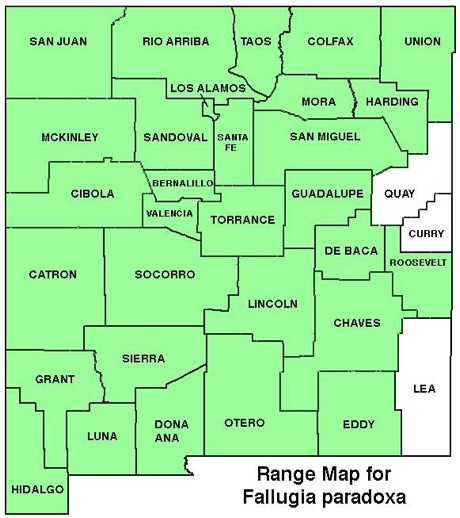WILDFLOWERS OF NEW MEXICO

With multiple, branching, woody stems reaching 3–8 feet tall and wide, this bushy shrub is covered with small, wedge-shaped leaves and clusters of showy, white, cup-shaped flowers. Note the seeds have long, reddish, plume-like tails; common along washes and intermittent arroyos; thicket forming. As a popular ornamental shrub in native plant landscapes, it attracts many pollinators.
FLOWER: April–September. Clusters on branch tips have 1–7 flowers, each 1 inch wide (25 mm) with 5 white petals, a central cluster of 15 or more pistils, and many showy yellow stamens. Flowers are bisexual or unisexual, females have sterile anthers, males have sterile ovaries. Seeds have reddish, feathery, twisted tails that cover the shrub with masses of showy plumes.
LEAVES: Alternate to clustered on short spurs (fascicules); blades fan-shaped, 1/4–3/8 inch long (6–8 mm), pinnately divided into 3–7 narrow lobes; edges rolled under, surfaces hairy.
HABITAT: Rocky slopes, flats, washes, canyons, hills; desert grasslands and scrub, pinyon-juniper foothills.
ELEVATION: 3,500–8,000 feet (1067-2438 m).
RANGE: AZ, CA, CO, NM, NV, OK, TX, UT.
SIMILAR SPECIES: A common companion plant, Cliffrose, Purshia stansburyana, in the western half of NM, has flowers with only 1–5 pistils, and seeds with white feathery tails. Antelope Bitterbush, Purshia tridentata, in Northern NM, doesn’t have seeds with feathery tails.
NM COUNTIES: Widespread, nearly statewide, not reported in Curry, Lea, Quay cos., in low– to mid-elevation, dry habitats: Bernalillo, Catron, Chaves, Cibola, Colfax, De Baca, Dona Ana, Eddy, Grant, Guadalupe, Harding, Hidalgo, Lincoln, Los Alamos, Luna, McKinley, Mora, Otero, Rio Arriba, Roosevelt, San Juan, San Miguel, Sandoval, Santa Fe, Sierra, Socorro, Taos, Torrance, Union, Valencia.









APACHE PLUME
FALLUGIA PARADOXA
Rose Family, Rosaceae
Deciduous, semi-evergreen shrub



























THE CONTENTS OF THIS WEBSITE ARE COPYRIGHTED AND CANNOT BE USED
WITHOUT PERMISSION OF GEORGE OXFORD MILLER
















EMAIL ME






















































Apache plume’s early spring to late summer flowers provide three-season nectar and pollen for an abundance of pollinators.









Adapted to arroyos and intermittent drainages, Apache Plume is a keystone pollinator plant in both desert habitats and in home landscapes.









Ornate seed heads cover the plant in the summer and fall.









The tiny, semi-evergreen leaves help adapt the shrub to arid desert habitats.
















